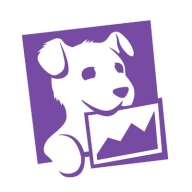

Datadog and Logpoint are significant players in the monitoring and security management sectors. Datadog takes the lead in breadth and integrations across cloud services, while Logpoint shines with its focus on security through SIEM and SOAR integration.
Features:Datadog stands out with centralized monitoring, shareable dashboards, and a vast range of integrations with technology stacks like AWS and Docker. Its alerting systems and visualization tools are also highly valued. Logpoint focuses on integrating SIEM and SOAR for robust event correlation and log management solutions, particularly suitable for environments with demanding security needs.
Room for Improvement:Datadog could enhance performance for accessing older data, introduce more consistent API features, and simplify its pricing model. Challenges in learning curves and alert configurations also need attention. Logpoint should focus on improving its user interface aesthetics, third-party integrations, and expanding automation capabilities in security management.
Ease of Deployment and Customer Service:Datadog offers versatile deployment options across private, public, and hybrid clouds, with proactive customer service. However, regional support consistency needs improvement. Logpoint requires strong IT infrastructure for optimal performance but provides rapid and tailored customer support for security management.
Pricing and ROI:Datadog's pricing can be high, particularly for storage features, but offers time savings in bug tracking and system monitoring as ROI. Its flexible billing model requires effective cost management. Logpoint offers a straightforward pricing model based on device count, advantageous for predictable budgeting in log-intensive environments.
The technical support for Logpoint is very good, and I would rate it as nine out of ten.
Logpoint's customer support is not sufficient with only one engineer in the US.
It is web-based and accommodates the expansion of our organization.
Logpoint is scalable and capable of expanding.
I have received reports indicating glitches and downtimes with Logpoint.
The documentation is adequate, but team members coming into a project could benefit from more guided, interactive tutorials, ideally leveraging real-world data.
There should be a clearer view of the expenses.
Dealing with foreign entities for support was a challenge, leading us to switch providers due to lack of adequate support.
Logpoint needs to be cloud-native, as currently, it is not.
The setup cost for Datadog is more than $100.
I rate the pricing at eight, suggesting it's relatively good or affordable.
Our architecture is written in several languages, and one area where Datadog particularly shines is in providing first-class support for a multitude of programming languages.
The technology itself is generally very useful.
The UEBA enables us to monitor at the device level, and SOAR provides playbooks and templates that we can modify and incorporate into the platform.
It effectively facilitates logging and log storage and assists in security event management by ingesting security events.


Datadog is a comprehensive cloud monitoring platform designed to track performance, availability, and log aggregation for cloud resources like AWS, ECS, and Kubernetes. It offers robust tools for creating dashboards, observing user behavior, alerting, telemetry, security monitoring, and synthetic testing.
Datadog supports full observability across cloud providers and environments, enabling troubleshooting, error detection, and performance analysis to maintain system reliability. It offers detailed visualization of servers, integrates seamlessly with cloud providers like AWS, and provides powerful out-of-the-box dashboards and log analytics. Despite its strengths, users often note the need for better integration with other solutions and improved application-level insights. Common challenges include a complex pricing model, setup difficulties, and navigation issues. Users frequently mention the need for clearer documentation, faster loading times, enhanced error traceability, and better log management.
What are the key features of Datadog?
What benefits and ROI should users look for in reviews?
Datadog is implemented across different industries, from tech companies monitoring cloud applications to finance sectors ensuring transactional systems' performance. E-commerce platforms use Datadog to track and visualize user behavior and system health, while healthcare organizations utilize it for maintaining secure, compliant environments. Every implementation assists teams in customizing monitoring solutions specific to their industry's requirements.
Logpoint is a cutting-edge security information and event management (SIEM) solution that is designed to be intuitive and flexible enough to be used by an array of different businesses. It is capable of expanding according to its users' needs.
Benefits of Logpoint
Some of the benefits of using Logpoint include:
Reviews from Real Users
Logpoint is a security and management solution that stands out among its competitors for a number of reasons. Two major ones are its data gathering and artificial intelligence (AI) capabilities. Logpoint enables users to not only gather the data, but also to maximize both the amount of data that can be gathered and its usefulness. It removes many of the challenges that users may face in data collection. The solution allows users to set rules for collection and then it pulls information from sources that meet the rules that have been set. This data is then broken into manageable segments and ordered. Users can then analyze these ordered segments with ease. Additionally, LogPoint utilizes both machine learning and AI technology. Users gain the ability to protect themselves from and if necessary resolve emerging threats as soon as they arise. The AI sets security parameters for a user’s system. These act as a baseline that are triggered and notify the user if anything deviates from the rules that it set up.
The chief infrastructure & security officer at a financial services firm writes, “It is a very comprehensive solution for gathering data. It has got a lot of capabilities for collecting logs from different systems. Logs are notoriously difficult to collect because they come in all formats. Logpoint has a very sophisticated mechanism for you to be able to connect to or listen to a system, get the data, and parse it. Logs come in text formats that are not easily parsed because all logs are not the same, but with Logpoint, you can define a policy for collecting the data. You can create a parser very quickly to get the logs into a structured mechanism so that you can analyze them.”
A. Secca., a Cyber Security Analyst at a transportation company, writes, “It is an AI technology because it is using machine learning technology. So far, there is nothing better out there for UEBA in terms of monitoring endpoints and user activity. It is using machine learning language, so it is right at the top. It provides that capability and monitors all of the user’s activities. It devises a baseline and monitors if there is any deviation from the baseline.”
We monitor all Log Management reviews to prevent fraudulent reviews and keep review quality high. We do not post reviews by company employees or direct competitors. We validate each review for authenticity via cross-reference with LinkedIn, and personal follow-up with the reviewer when necessary.